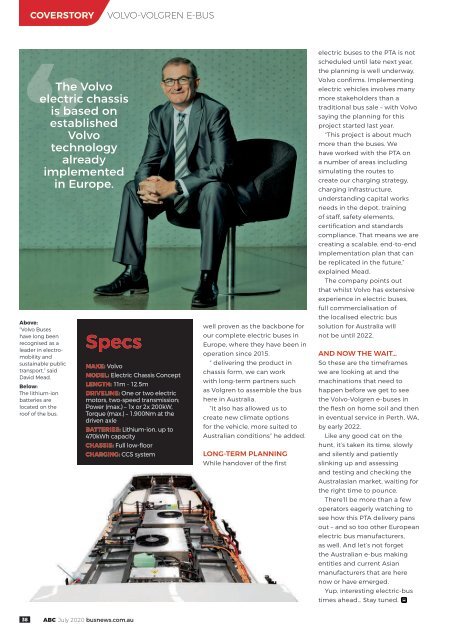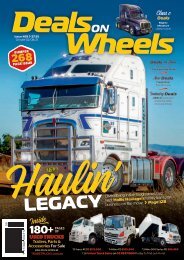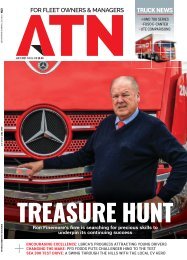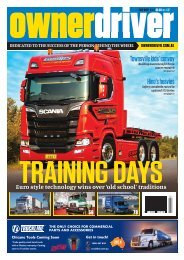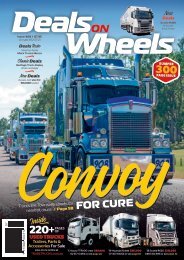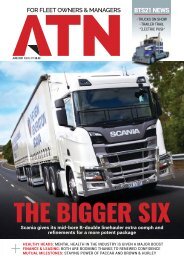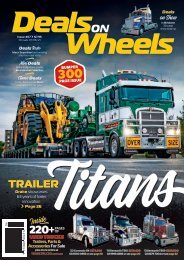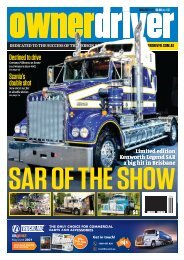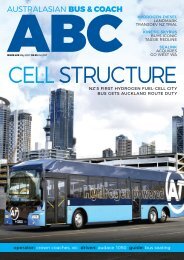ABC #395
You also want an ePaper? Increase the reach of your titles
YUMPU automatically turns print PDFs into web optimized ePapers that Google loves.
COVERSTORY<br />
VOLVO-VOLGREN E-BUS<br />
The Volvo<br />
electric chassis<br />
is based on<br />
established<br />
Volvo<br />
technology<br />
already<br />
implemented<br />
in Europe.<br />
Above:<br />
“Volvo Buses<br />
have long been<br />
recognised as a<br />
leader in electromobility<br />
and<br />
sustainable public<br />
transport,” said<br />
David Mead.<br />
Below:<br />
The lithium-ion<br />
batteries are<br />
located on the<br />
roof of the bus.<br />
Specs<br />
MAKE: Volvo<br />
MODEL: Electric Chassis Concept<br />
LENGTH: 11m - 12.5m<br />
DRIVELINE: One or two electric<br />
motors, two-speed transmission;<br />
Power (max.) – 1x or 2x 200kW,<br />
Torque (max.) – 1,900Nm at the<br />
driven axle<br />
BATTERIES: Lithium-ion, up to<br />
470kWh capacity<br />
CHASSIS: Full low-floor<br />
CHARGING: CCS system<br />
well proven as the backbone for<br />
our complete electric buses in<br />
Europe, where they have been in<br />
operation since 2015.<br />
“ delivering the product in<br />
chassis form, we can work<br />
with long-term partners such<br />
as Volgren to assemble the bus<br />
here in Australia.<br />
“It also has allowed us to<br />
create new climate options<br />
for the vehicle, more suited to<br />
Australian conditions” he added.<br />
LONG-TERM PLANNING<br />
While handover of the first<br />
electric buses to the PTA is not<br />
scheduled until late next year,<br />
the planning is well underway,<br />
Volvo confirms. Implementing<br />
electric vehicles involves many<br />
more stakeholders than a<br />
traditional bus sale – with Volvo<br />
saying the planning for this<br />
project started last year.<br />
“This project is about much<br />
more than the buses. We<br />
have worked with the PTA on<br />
a number of areas including<br />
simulating the routes to<br />
create our charging strategy,<br />
charging infrastructure,<br />
understanding capital works<br />
needs in the depot, training<br />
of staff, safety elements,<br />
certification and standards<br />
compliance. That means we are<br />
creating a scalable, end-to-end<br />
implementation plan that can<br />
be replicated in the future,”<br />
explained Mead.<br />
The company points out<br />
that whilst Volvo has extensive<br />
experience in electric buses,<br />
full commercialisation of<br />
the localised electric bus<br />
solution for Australia will<br />
not be until 2022.<br />
AND NOW THE WAIT…<br />
So these are the timeframes<br />
we are looking at and the<br />
machinations that need to<br />
happen before we get to see<br />
the Volvo-Volgren e-buses in<br />
the flesh on home soil and then<br />
in eventual service in Perth, WA,<br />
by early 2022.<br />
Like any good cat on the<br />
hunt, it’s taken its time, slowly<br />
and silently and patiently<br />
slinking up and assessing<br />
and testing and checking the<br />
Australasian market, waiting for<br />
the right time to pounce.<br />
There’ll be more than a few<br />
operators eagerly watching to<br />
see how this PTA delivery pans<br />
out – and so too other European<br />
electric bus manufacturers,<br />
as well. And let’s not forget<br />
the Australian e-bus making<br />
entities and current Asian<br />
manufacturers that are here<br />
now or have emerged.<br />
Yup, interesting electric-bus<br />
times ahead… Stay tuned.<br />
38<br />
<strong>ABC</strong> July 2020 busnews.com.au


